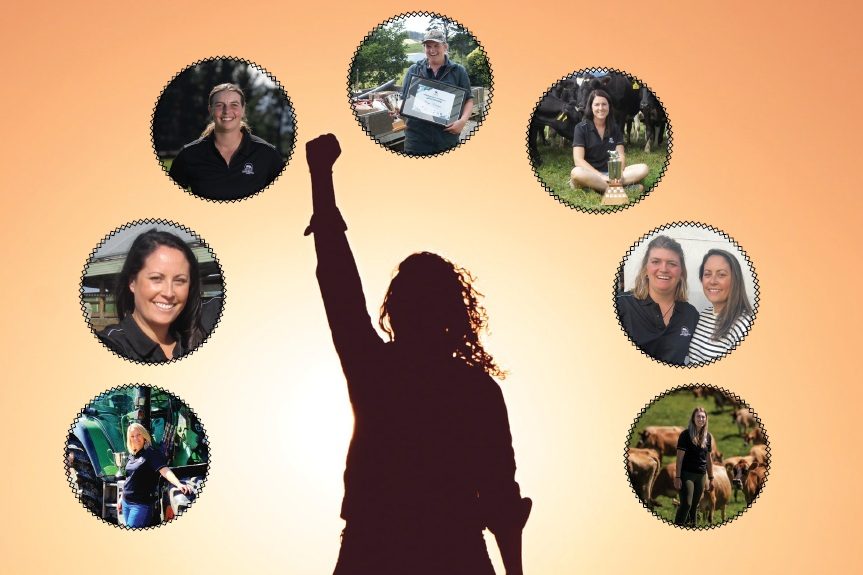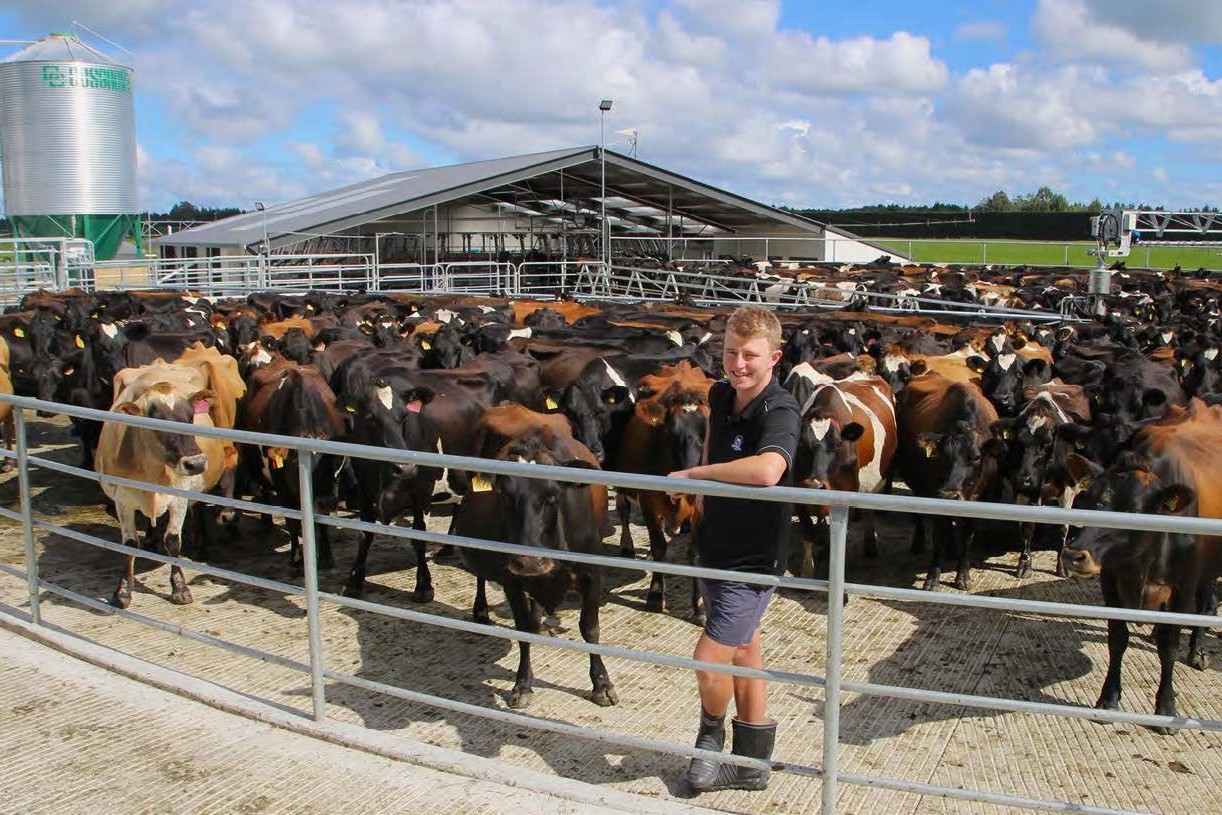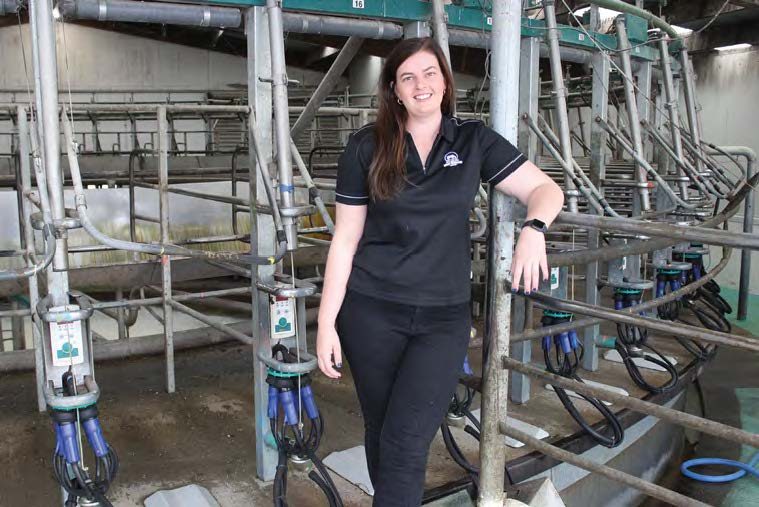Jackie Harrigan
Hamish Hammond and Rachel Gardner have two degrees and two masters qualifications between them, now their practical application of theory has been judged award-winning also.
The Hawke’s Bay/Wairarapa 2019 winning share farmers are contract milking on Hamish’s family farm on the outskirts of Greytown in Wairarapa. The pair met at Massey University when Rachel, now 24 and who hailed from a Nelson apple orchard, had completed her degree in animal science and was undertaking a masters in the same.
Rachel’s research project involved analysing the 1.5 million productive performance and survival records for carryover cows in the LIC database. Results showed that second lactation carryover cows produced 36% more MS than first lactation cows, a production advantage that continued for three subsequent seasons. Carryover cows also had a production advantage over age-matched and lactation-matched non-carryover cows.
Carryover cows could be a good option if a farmer has runoff land to graze them, reducing the number of replacements required, and capturing the greater MS production, Rachel says, especially if the carryover is a high-value cow, and there was a known reason why she failed to conceive.
Now 28, Hamish completed a B Ag Com (Hons) in 2015 and was competing in high-level triathlon events, in New Zealand and overseas with considerable success “but very little financial rewards” and when his farming grandfather died he decided to come home and finish his studies. His masters in agri commerce focused on information systems for dairy farmers. He focused on animals and feed and interviewed six dairy farmers and six tech providers trying to make connections between what the farmers needed and what technologies were available.
“It was great to see how good the farmers were at getting data and how they were using it – predictably accessibility is a high need and a high priority is the usability of technology when farmers are out on their farms and on the go,” Hamish says.
“It was also interesting seeing what the priorities were for developers.”
Leaving the academic lifestyle to plunge themselves into farming 400 cows milking twice a day with Hamish’s parents Stephen and Maree was difficult mentally and physically but the couple wanted to grow their practical knowledge. Entering a contract milking position with Stephen and Maree as equal partners was an ideal way to grow but be supported and guided by the older couple.
“The arrangement really eased our transition into the farm and because we were all 25% owners and partners we made all decisions in consultation with the other.”
Their accountant helped them to set up the structure of the registered company business and Stephen and Maree put in the float to get the business started. All partners were paid an hourly wage on a time sheet with the hourly rate based on the preceding four years financial accounts.
“We are not trying to grow the asset, but the idea is that we can take our returns to use it as we want to.”
“One of the biggest things is that we are not trying to milk the owners of cash – everything is considered with them in mind and looking to the longterm sustainability of the operation,” Hamish says.
For this second season (2018/19) Maree was keen to step out and so Hamish and Rachel bought out her 25% share in the contract milking company.
The farm had been ticking over with Hamish’s parents winding down to system 3 from their previous system 4-5 operation and Hamish and Rachel have continued this strategy.
“We have been reducing grain usage, trying to grow more grass with the two pivots and long lateral irrigation systems and making better usage of it.”
Part of the sustainability equation was the move to OAD this season and with a high ratio of cows per labour unit the move has allowed the partners to put more time into R&M and development and fine-tuning of the operation.
“Now we have time to do development in the afternoons and can put more time into planning and strategy.”
It’s been a good move, Hamish says, with less mastitis, less lameness and better fertility results.
“We budgeted for five herd tests, anticipating high somatic cell counts might be an issue but we have seen heaps less mastitis – maybe from less exposure to the cups.
“Only milking once-a-day has meant less hours working in total and lots more hours to think about and plan stuff around the farm and farming system.”
While the couple budgeted on a 13% reduction in production over the first season, they say the cows are in good condition from only milking once each day and will be able to milk until late May rather than the usual April dry off, minimising the production loss.
With advice from other OAD farmers, Stephen had been breeding towards an OAD herd for the last five years using more Jersey and Kiwi cross genetics over the Friesian herd.
Rachel has taken responsibility for the breeding strategy of the herd this season and when they arrived on the farm the first thing to do was to shorten up the 15-week calving spread which was “way too long”, she says.
“We decided we needed a quick way to cut off all the late-cyclers so we cut breeding to eight weeks of AB only in our first season – it resulted in a 16% empty rate and put lots of selection pressure on but we achieved a 10-week calving.”
Milking the 85 empty cows through the winter provided a handy financial buffer.
Now Rachel has reorganised the mating with input from the LIC rep to move from mating all cows to Premier sires to mating the top 60% to OAD sires and the bottom 40% to Herefords to generate beef calves for sale.
“We will reduce the number of bobby calves and cut down on the excessive number of replacement females that were being kept and increase the selection intensity by only keeping heifers from the top producing cows – while still having some excess heifers for sale.”
They have also taken back the grazing management of their young replacement stock, saying that OAD has given them the time to manage them to ensure good weight gains, and bringing them back to the support land on the farm has made sound financial sense.
Tech bent
Hamish’s focus on farm technology is slowly winding up systems and efficiency on the farm.
The couple uses MINDA Land and Feed to create feed wedges, Grass to Milk is used as a feed supply and demand calculator and Farmax, Pasture Growth forecaster and the DairyNZ Spring rotation planner are all used across the season on the Hammond farm. SPACE pasture monitoring has been trialed as a pilot farm and Hamish is looking forward to a time when it is accurate enough for them to use fulltime.
The Fonterra On Farm App is handy to monitor production and SCC, and while Hamish says onfarm heat detection tools would be handy, he says he can’t justify spending the setup cost for a marginal benefit of a higher in-calf rate over just using tail painting.
Irrigation has been an area of improving efficiency through technology. Hamish says they had a gut feeling that they were using too much water and employing soil monitoring company Hydro Services to give weekly soil moisture readings with neutron probes resulted in a net saving of $8000 in electricity and water.
Consistent annual or biannual soil testing will give an idea of the limiting nutrient factor in each of the different management zones and Hamish is enjoying using the Tracmap mapping tool to choose and record and provide proof of placement of the fertiliser.
“The mapping tool is actually really good for doing pasture allocations too.”
Along with paddock development, the couple have designed and planned riparian plantings of the fenced-off farm creeks and last year planted 1,000 trees on one area, in conjunction with the Papawai Stream Care Group.
“The Fonterra Tiaki farm environment plan has given us goals to work on and has been a very thorough process.”
Recycling and rubbish management has been overhauled, opting for Plasback and AgRecovery recycling services.
“The farm is placed on a popular walking and cycling route and we are surrounded by lifestyle blocks being this close to town – so its important to us that we are doing the right thing with our waste.”
Hamish and Rachel have a strategy to be 50:50 sharemilking within the next five years and know they need to save up a large sum to get them into an equity position to do so. Buying a rental property in the next couple of years is part of the plan, alongside rearing beef calves to weaners, taking on a lease to finish them and rearing replacement heifers to sell.
When they buy the herd they are both keen on employing staff and pursuing off-farm roles in industry, governance or research while having links to the farm and being involved in an equity partnership, perhaps with Hamish’s three non-farming siblings.
“Once we have been through this consolidation period we hope to change the trajectory of the business to be on a growth path – bringing in other farms and partners are all possibilities for the future,” Hamish said.
The farm near Greytown.
SHARE FARMER MERIT AWARDS:
DairyNZ Human Resources Award – Liam and Margot Richardson.
Ecolab Farm Dairy Hygiene Award – Kirstin and Scott Mathis.
Federated Farmers Leadership Award, Honda Farm Safety, Health and Biosecurity Award – Nicholas and Rosemarie Bertram.
LIC Recording and Productivity Award, Meridian Energy Farm Environment Award, Ravensdown Pasture Performance Award, Westpac Business Performance Award – Hamish Hammond and Rachel Gardner.





